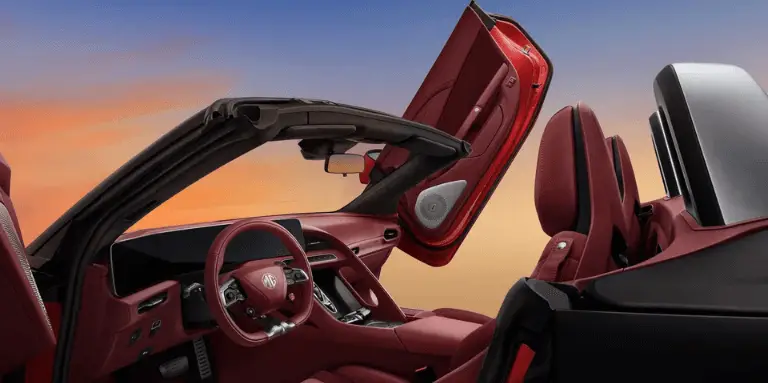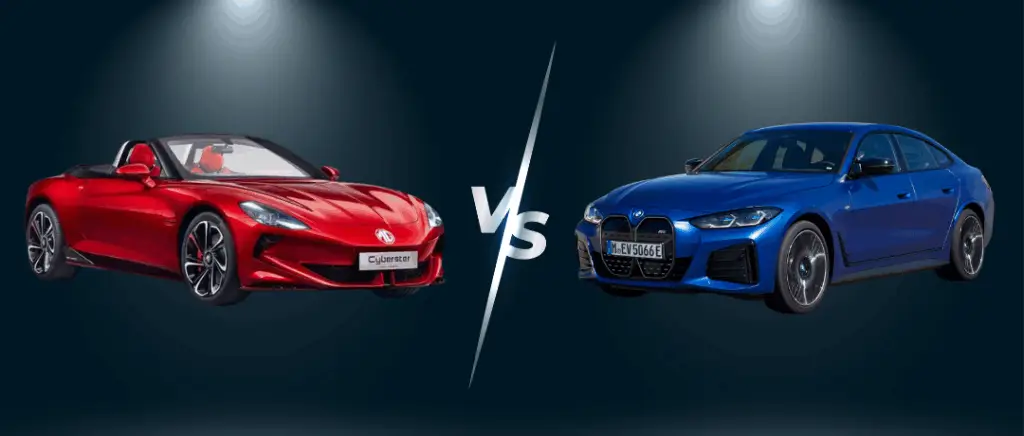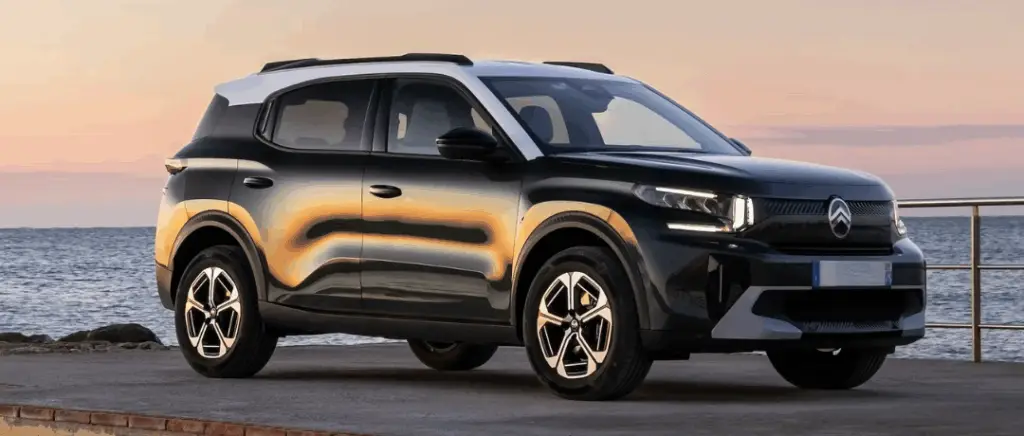MG Cyberster vs BMW i4: what are the differences in design and brand image?
Design is a determining factor. It is the first visible criterion, and it directly influences the image projected by a manager or a company. The choice between the MG Cyberster and the BMW i4 M50 crystallises the evolution of car fleets towards premium electric vehicles, combining innovation, performance and regulatory issues. These two electric coupés each embody a vision of tomorrow's mobility, and differ in their approach to design and the driving experience. Here are their differences:
A design that reflects two philosophies:
- The MG CybersterThis boldly designed two-seater roadster boasts sculpted lines, spectacular gullwing doors and a resolutely sporty look. Its highly expressive styling makes it a real 'showcase vehicle', ideal for fleets wishing to stand out from the crowd and communicate innovation. Its spectacular design makes it more of an image tool than a day-to-day fleet vehicle.
- BMW i4 M50 This is a more restrained top-of-the-range coupé saloon, but one that is immediately recognisable thanks to its 'double kidney' grille and the styling cues of the M range. It retains a reassuring image of performance, quality and technology, a key asset for a fleet's internal prestige and employer image.
Brand image and corporate perception :
- MG Cyberster MG: builds on MG's British heritage (the famous roadsters of the 60s and 70s), but under the flag of the Chinese group SAIC. Its positioning is challenging: bold and differentiated, but with credibility still to be built among fleet and sustainable mobility decision-makers.
- BMW i4 M50 The BMW range: a continuation of BMW's DNA of premium quality and driving pleasure. It enjoys strong international recognition and an image consistent with an ambitious CSR policy (credible energy transition, reliability, extensive after-sales service).
Involvement for fleets and CSR:
- The MG Cyberster can raise the profile of an innovative company at events, as a showcase vehicle for management or CSR communications.
- The BMW i40 M50 is a more rational and sustainable choice: it combines versatility and credibility in a company fleet, while promoting a responsible, premium image.
| Criteria | MG Cyberster | BMW i4 M50 |
|---|---|---|
| Type of vehicle | 2-seater convertible roadster | 5-door coupé (Gran Coupé) |
| Design | Spectacular, gullwing doors, soft top, showcase look | Elegant, BMW grille, premium sportiness, more restrained |
| Brand image | MG heritage (historic roadsters), Chinese brand SAIC | Premium international, high residual value, CSR credibility |
| Corporate use | Image / management / communication vehicle | Premium company vehicle, suitable for fleets |
With Beev
Switch to
Electric cars
or install your
Charging station
For individuals and businesses
MG Cyberster vs BMW i4: which engine and electric performance should you choose?

Performance is not just a question of driving pleasure: it also has an impact on the quality of life. safety, journey efficiency and driver perceived value.
- MG Cyberster With its twin-engine configuration, it develops 510bhp, enabling it to accelerate from 0 to 100kph in 3.2 seconds. Acceleration is lightning fast, and the sporting DNA is clear. However, this approach can be perceived as less rational for a fleet, as sportiness often translates into higher fuel consumption.
- BMW i4 M50 The i4 M50: equipped with two electric motors (one per axle), the i4 M50 develops 544bhp and accelerates from 0 to 100kph in 3.9 seconds, which is slightly less powerful but in the same sporting vein. The BMW advantage lies in the optimisation of its electric transmission and the thermal management of its batteries, the fruit of the German manufacturer's experience in electrification.
Range is a key criterion for company fleets, particularly with the new European regulations on emissions and carbon reporting obligations. The more efficient the battery, the more flexibility and peace of mind employees can enjoy on their business trips.
Both models feature advanced lithium-ion batteries and intelligent thermal management.
MG Cyberster: LFP battery and everyday versatility
The MG Cyberster has a 77 kWh battery with a WLTP range of around 440 kilometres. That's enough capacity to cover the majority of daily business trips without any major constraints.
- AC Recharge : approximately 10H30 on a conventional plug.
- DC fast recharge : up to 144 kW, enabling you to go from 10 to 80% in around 38 minutes.
- LFP (Lithium Iron Phosphate) technology This means greater longevity, enhanced safety and greater resistance to charging cycles - an important asset for intensive fleet use.
The Cyberster's appeal lies in its robustness and innovative approach, but its recharging speed is still slightly slower than that of the BMW.
BMW i4 M50: extended range and more efficient recharging
The BMW i4 M50 is equipped with an 83.9 kWh battery, offering a WLTP range of up to 520 km. This performance is the result of aerodynamics and BMW's expertise in energy management.
For managers and employees who regularly travel long distances, this extended range significantly reduces the anxiety associated with recharging.
- AC Recharge time: approx. 8 hours.
- DC fast recharge up to 200 kW, enabling 80% to be recovered from the charge in just 35 minutes.
The BMW i4 M50 thus combines greater range, faster recharging and energy efficiency, making it a solution more suited to the intensive use of a top-of-the-range fleet.
Things to remember for fleet managers:
- The MG Cyberster focuses on the longevity and robustness of its LFP battery, with a range suited to urban and suburban journeys.
- The BMW i4 M50 offers longer range and faster recharging, making it easier to optimise journey times for employees on the move.
For individuals and businesses
Add your title here
MG Cyberster vs BMW i4: interior comfort and technology for driver and passengers?

Comfort and on-board technology have a direct impact on employee productivity and the company's image when travelling on business.
- The MG Cyberster opts for a modern roadster style. It focuses on the driving experience, with a driver-oriented two-seater cabin. Its 12.3-inch central screen and 7-inch digital instrument panel offer a modern, intuitive interface. The absence of a hardtop roof may be a limitation for certain professional uses, particularly in adverse weather conditions or when transporting sensitive documents.
- The BMW i4 M50 is all about functional sophistication: it offers a four-seat cabin with a premium level of finish that is characteristic of the brand. The iDrive 8 system with curved 14.9-inch screen incorporates BMW's latest innovations in connectivity and driver assistance. Electric sports seats with massage function are an asset on long business trips.
To remember For CSR managers, it is worth noting that BMW is emphasising the use of recycled and sustainable materials in the i4's cabin, in response to the growing demands of companies in terms of environmental responsibility.
MG Cyberster vs BMW i4: price and value for money?

Financial analysis is crucial for company decision-makers, especially as electric vehicles for business use benefit from significant tax advantages.
- The MG Cyberster has a base price of around €65,000, which is competitive for a high-performance electric vehicle. In France, the list price is around €75,000, which is still attractive compared with competing premium models. For companies, it is eligible for the environmental bonus, optimised TV deductibility and partial or total exemption from TVS.
- The BMW i4 M50 starts at around €80,000, reflecting the brand's premium positioning. This €15,000 price difference may seem significant, but it should be put into perspective with the tax benefits and higher residual value of BMW vehicles.
The two vehicles enable companies to comply with European emissions standards and simplify their carbon reporting obligations, which are coming under increasing scrutiny from stakeholders.
MG Cyberster vs BMW i4: which driving experience is right for daily use and long journeys?
For fleet managers, executives and CSR managers, the driving experience is not just a marketing argument. It has a direct influence on :
- Employee well-being,
- Productivity (fatigue, comfort on long journeys),
- Operating costs (wear and tear, maintenance, consumption),
- as well as the ability to comply with legal obligations (safety, environmental standards).
MG Cyberster: pure pleasure and urban agility
Its precise steering and rigid chassis provide genuine pleasure, particularly on twisty roads.
In urban or suburban use, the Cyberster's manoeuvrability and responsiveness are ideal for short, dynamic journeys.
BMW i4 M50: premium comfort and versatility
Its chassis/power balance ensures dynamic driving without sacrificing comfort.
Soundproofing, adaptive suspension and driving aids enhance the car's well-being on motorways and long journeys.
Its five seats and spacious interior make it a model that's well-suited to everyday business use.
MG Cyberster vs BMW i4: which vehicle to choose as a company car

Making the right choice of company car isn't just about performance or looks. For companies, it's also a question of :
- taxation (ecological bonus, TVS exemption, benefits in kind)
- social responsibility (CSR image, sustainable mobility),
- Total cost of ownership (TCO),
- and employer appeal to employees.
In this comparison, we pit two iconic models against each other: the MG Cyberster, a bold sports coupé, and the BMW i4 M50, a premium electric saloon.
- MG Cyberster It's more affordable to buy, has a distinctive image and is an interesting way of reinforcing CSR communications. However, its lack of versatility (two seats, small boot) and a limited after-sales network in Europe could pose problems for a fleet.
- BMW i4 M50 It's more expensive, but it makes up for it with superior comfort, a premium image, a solid service network and a high residual value. It's part of a sustainable mobility strategy that's both credible and secure for a fleet.
The BMW i4 M50 is still the best choice for a company car that combines long-distance comfort, reliability and prestige. It costs more, but it offers peace of mind in use, a more controlled TCO over the long term and an image consistent with an ambitious CSR policy.
If the main objective is to optimise costs while enhancing the image of innovation and sustainability, the MG Cyberster may represent a credible alternative.
MG Cyberster vs BMW i4 comparison chart
| Criteria | MG Cyberster | BMW i4 M50 |
|---|---|---|
| Type of vehicle | 2-seater convertible roadster | 5-door coupé saloon (Gran Coupé) |
| Design | Daring, spectacular, butterfly doors | Elegant, premium, soberly sporty |
| Brand image | Innovative, differentiating, MG heritage under SAIC | Premium, statutory, high residual value |
| WLTP range | ≈ 440 km (77 kWh battery, LFP) | ≈ 520 km (83.9 kWh battery) |
| DC fast recharge | 144 kW → 10-80 % in ~38 min | 200 kW → 10-80 % in ~35 min |
| Prices (France) | 62,990 - €67,990 INCL. VAT | 71,000 - 77,000 € EXCL. TAX |
| Benefits in kind (AEN) | Lower (lower price, EV allowance) | Higher (higher value, VE allowance) |
| TCO (total cost of ownership) | More affordable to buy, but keep an eye on after-sales service and discounts | More expensive, but high residual value and reliable network |
| Practical | Limited use (2 seats, reduced boot space) | Versatile, spacious, fleet-friendly |
| Driving experience | Pure pleasure, agile in town and on winding roads | Premium comfort, ideal for long journeys |
| Network / service | Still limited in Europe | Solid BMW network + partnership Ionity |
| Fleet / CSR relevance | Image and communication tools, innovation | A rational, sustainable and credible company vehicle |
The choice between the MG Cyberster and the BMW i4 M50 should be made on the basis of fleet usage, the desired image (sporty or premium), CSR culture and overall mobility strategy. The Cyberster seduces with its disruptive design and driving pleasure; the i4 reassures with its technology, reputation and comfort. Both meet 2025 regulatory requirements and facilitate extra-financial reporting, while optimising corporate taxation on electric vehicles.
































